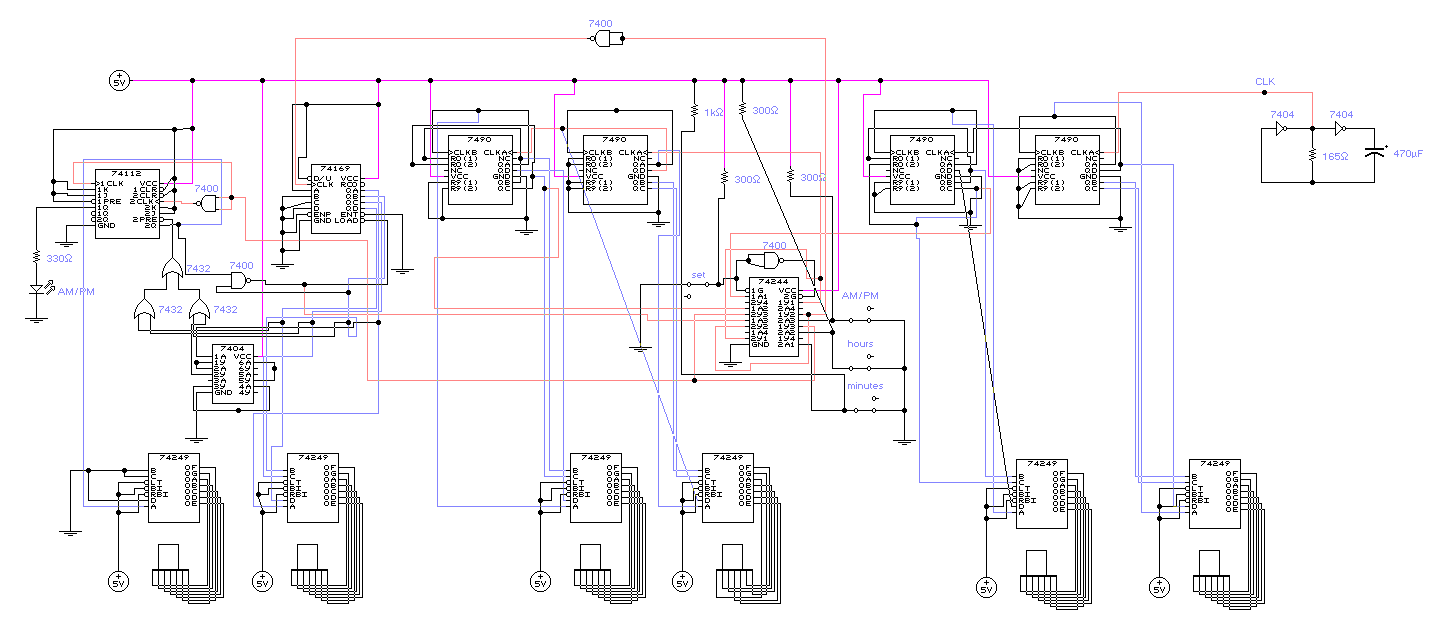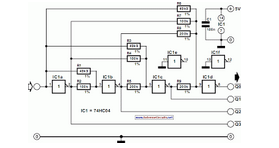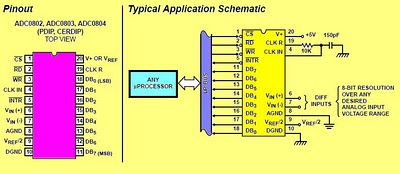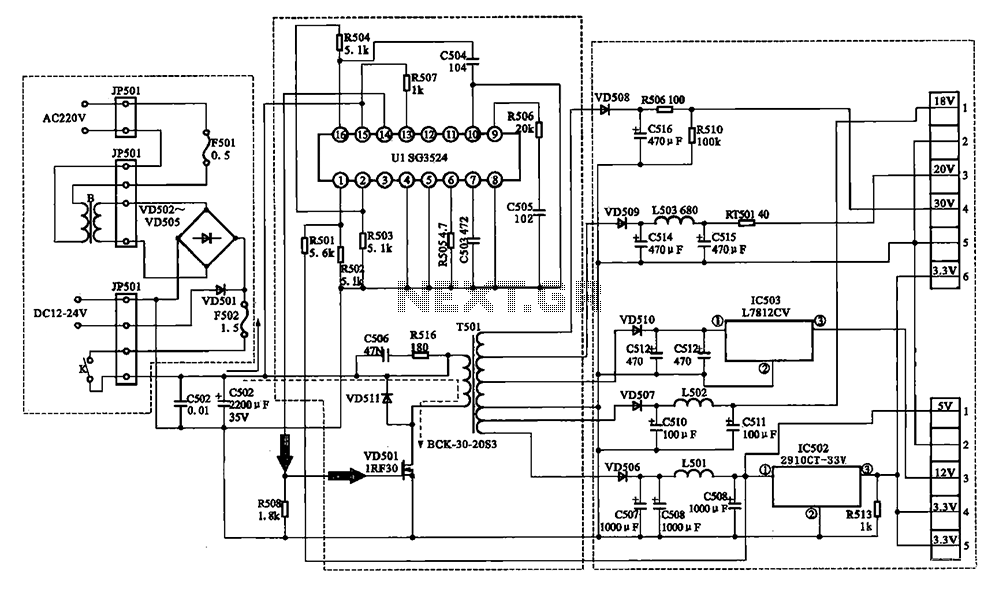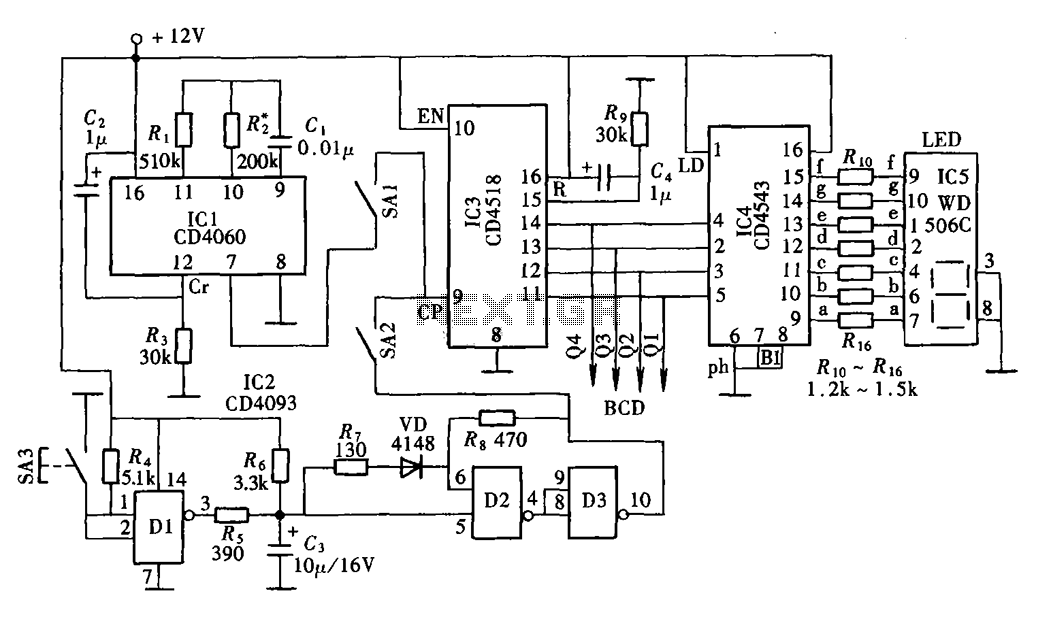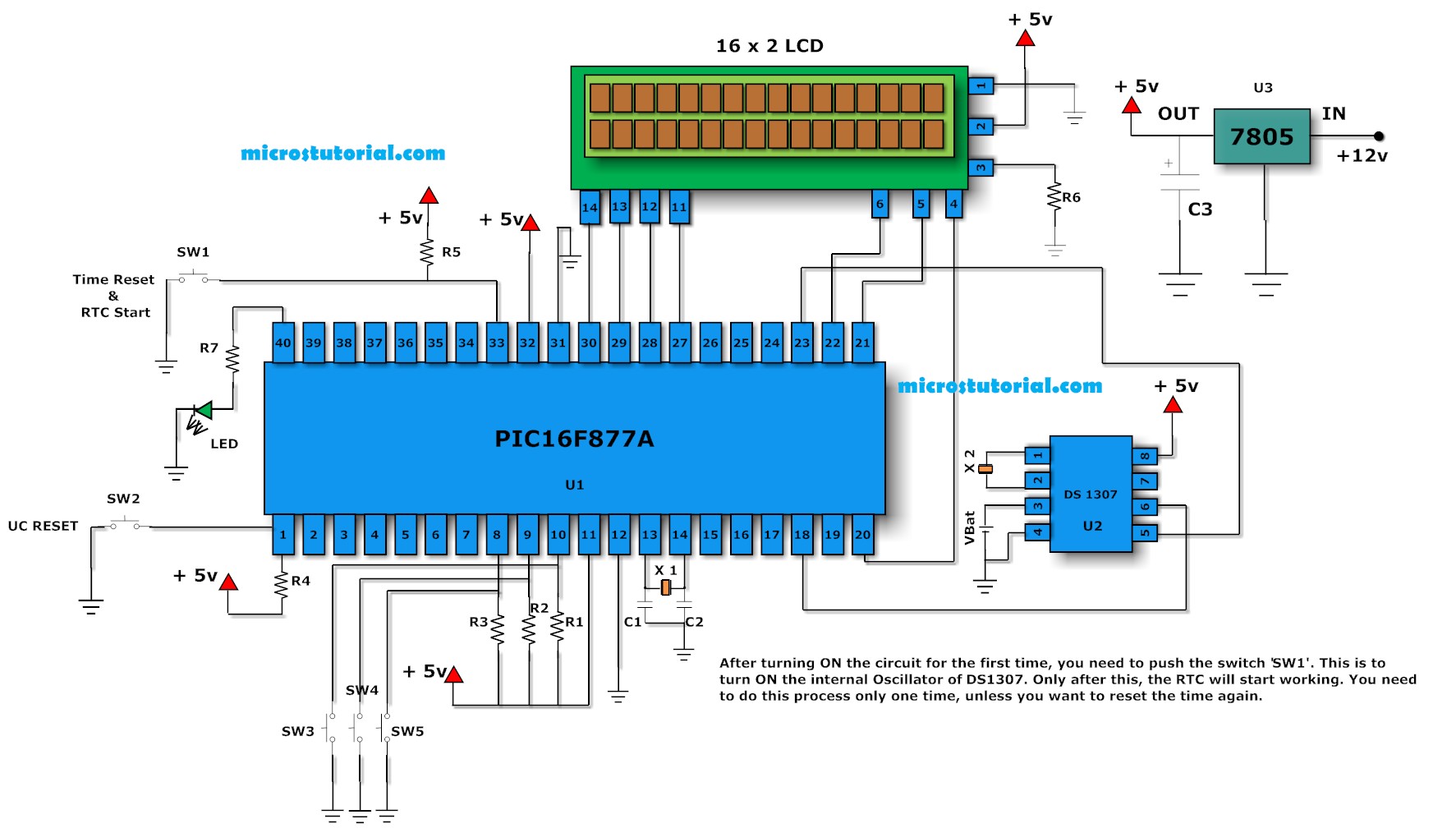
rf digital

It is important to mention that the 74HC240 can directly drive an IRF510 FET transistor, capable of delivering up to 10W. Another application is using it to drive a balanced diode mixer, which requires considerable power that can be easily supplied by a 74HC240 gate. Tests were conducted with a Philips 74HC240, which costs approximately R$1.00 (U$0.30 in September 2003). The 74HCT240 was also used with the same results, and a 74HC244 (SMD) was employed as a buffer because it does not function as an oscillator (it is not an inverter gate, but it has the same pin configuration as the 240). Tests with the 74F240 indicated that this type does not operate under these conditions. Another important fact is that each gate output impedance is about 16 Ohms. Therefore, connecting four in parallel results in an output impedance of around 4 Ohms. Impedance matching is typically performed using a low-pass tuner with a low Q (around 1) or with broadband transformers or trifilar coils. Digital oscillators generate square waves, which are not suitable for transmission in most mixers. However, filtering them with low-pass filters eliminates the harmonics; square waves are composed of a fundamental wave and its odd harmonics, and removing the harmonics yields the desired sinusoidal wave. Additionally, the use of an exclusive-OR (XOR) as a mixer for square waves simplifies its application in superheterodyne receivers and known universal VFOs. For those interested in experimentation, working with digital signals has been relatively unexplored. This project was built in about three hours, and by the end of the tests, a QSO was achieved with Rio de Janeiro, using only 0.3W and achieving a 579 report. The construction employed the dead bug method, with the rig affixed (using thermal conductive paste) to an aluminum board, which serves as a heat sink and increases the mechanical rigidity of the rig. The coils were formed using a pencil as a mandrel, and while the wire diameter (as long as it remains rigid and self-supporting) is not critical, the winding length is essential and must be adjusted for optimal output signal. An 74HCT240 oscillator and buffer-PA were utilized for transmitter purposes, enabling the use of varicap diodes with ceramic resonators. To increase the output impedance, a push-pull configuration was implemented using three gates on each side, with an additional inverter driving a trifilar coil, raising the impedance by four times to approximately 48 Ohms. This project describes a 40m transceiver utilizing two ICs and a regulator, employing the 74HC240 as the ceramic resonator (or crystal) VXO, as well as the buffer for the mixer and the PA. The mixer employs a diode ring, and the audio amplifier is an LM1458 dual operational IC. In all constructed and tested projects, it was noted that when the impedances are correctly matched (or nearly so), the IC generates minimal heat, and even when powered with 8V, the IC does not exhibit significant heating. The 74HC240 was initially used in transmitters by American radio amateur N7KSB, who constructed versions for 10m (0.9W), 15m, and 20m (0.5W), achieving contacts with over 30 countries and all continents using a vertical ground plane antenna.
The 74HC240 is a hex buffer/driver with high-speed CMOS technology, making it suitable for applications requiring high drive capability. The ability to drive FETs like the IRF510 directly allows for efficient power amplification in RF applications. The balanced diode mixer application showcases the versatility of the 74HC240 in handling high power levels, particularly in amateur radio setups where signal integrity is paramount. The output impedance characteristics are significant for impedance matching, which is crucial in RF design to maximize power transfer and minimize signal reflections. The use of low-pass filters to smooth out square wave outputs is a common practice in RF design, ensuring that the transmitted signal is clean and meets spectral requirements.
In the context of amateur radio, the project demonstrates practical applications of digital ICs in RF circuits, highlighting the potential for innovative designs using standard components. The construction techniques employed, such as the dead bug method, illustrate efficient use of space and thermal management in compact designs. The incorporation of varicap diodes and ceramic resonators expands the functionality of the transceiver, allowing for frequency agility and stability, which are essential in modern communication systems. Overall, the integration of these components and techniques illustrates the potential for creativity and experimentation in the field of electronics, particularly in the domain of amateur radio.It is important yet to mention that the 74HC240 can drive directly an IRF510 FET transistor being able to give until 10W. Another application is using it to drive a balanced diode mixer, which needs a considerable power drive, easily supplied by a 74HC240 gate.
We did some tests with a Philips 74HC240, with a cost of almost R$1. 00 (U$0. 30 in sept/ 2003), we use also the 74HCT240 with the same results, we also used a 74HC244 (SMD) as a buffer because it does not work as oscillator (it is not an inverter gate, but it has the same pin numeration as the 240), and the tests with the 74F240 showed this type does not work in this conditions! Another important fact is that each gate output impedance is about 16 Ohms, that is, connecting 4 in parallel we will have around 4 Ohms output, the matching is usually done with a low pass tuner with a low Q (around 1) or even with broad band transformers or trifilar coils.
The digital oscillators generate square waves which are not proper for transmitting and most of the mixer, but filtering them with low pass filters we get rid of the harmonics (for the one who does not know: the square waves are formed by the combination of a wave with its odd harmonics = getting rid of the harmonics we get the desired senoidal wave). Another interesting fact is the use of EXCLUSIVE-OR - XOR as mixer for square waves, easing its use in super heterodyne receivers and the known universal VFOs.
For the one who likes experimenting, this work with digital signals was always scarcely explored. We built this project in about 3 hours and by the end of the tests we got a QSO with Rio de Janeiro, with 0. 3W getting a 579. The construction was done by the dead bug method and the rig was stuck (using thermal conductor goo) on an aluminum board, serving as a heat sink and increases the mechanic stiffness of the rig.
The coils were made using a pencil as a former and the wire diameter (as long as it stands rigid and self-supported) does not matter - but the length of winding does and must be adjusted for the better output signal. 2. An 74HCT240 oscillator and buffer-PA for its use in transmitter, in this project we made possible the use of varicap diodes with ceramic resonators.
To increase the output impedance we chose to work in push-pull with 3 by 3 gates, note we use an additional inverter in one side, driving a trifilar coil raising the impedance by 4 times, ending close to 48 Ohms. Project of a 40m transceiver with 2 ICs and a regulator, it uses the 74HC240 as the ceramic resonator (or crystal) VXO, as the buffer for the mixer and as the PA.
The mixer uses a diode ring and as the audio amplifier we use the LM1458 double operational IC. See the details in the LACRAIA transceiver in this homepage. In all the built and tested projects, we note that when the impedances are correctly adjusted (or almost there) the IC heats very little and even powered with 8 V the IC does not show a lot of heating. O CI 74HC240 foi inicialmente utilizado em transmissores pelo radioamador americano N7KSB, que construiu versGµes para 10m (0, 9W), 15m e 20m (0, 5W) e com uma antena vertical plano terra conseguiu trabalhar mais de 30 paGses e todos os continentes.
Veja o link em : Importante ainda citar que o 74HC240 pode acionar diretamente um transistor FET IRF510 podendo render atG© 10W. Outra aplicaG§G£o G© o uso para acionamento de mixer a diodo balanceados que exigem uma potG ncia considerG vel para funcionar, o que uma porta do 74HC240 pode suprir facilmente.
Fizemos alguns testes com o 74HC240 da Philips, que esta custando cerca de R$1, 00 (U$0, 30 em set/2003), utilizamos tambG©m o 74HCT240 com os mesmos resultados, tambG©m utilizamos um 74HC244 (SMD) como buffer pois nG£o funciona como oscilador (nG£o G© porta inversora, mas tem a mesma numeraG§G£o de pinos do 240), jG os testes com o 74F240, mostraram que este tipo nG£o trabalha nestas condiG§Gµes ! Outro fato import 🔗 External reference
The 74HC240 is a hex buffer/driver with high-speed CMOS technology, making it suitable for applications requiring high drive capability. The ability to drive FETs like the IRF510 directly allows for efficient power amplification in RF applications. The balanced diode mixer application showcases the versatility of the 74HC240 in handling high power levels, particularly in amateur radio setups where signal integrity is paramount. The output impedance characteristics are significant for impedance matching, which is crucial in RF design to maximize power transfer and minimize signal reflections. The use of low-pass filters to smooth out square wave outputs is a common practice in RF design, ensuring that the transmitted signal is clean and meets spectral requirements.
In the context of amateur radio, the project demonstrates practical applications of digital ICs in RF circuits, highlighting the potential for innovative designs using standard components. The construction techniques employed, such as the dead bug method, illustrate efficient use of space and thermal management in compact designs. The incorporation of varicap diodes and ceramic resonators expands the functionality of the transceiver, allowing for frequency agility and stability, which are essential in modern communication systems. Overall, the integration of these components and techniques illustrates the potential for creativity and experimentation in the field of electronics, particularly in the domain of amateur radio.It is important yet to mention that the 74HC240 can drive directly an IRF510 FET transistor being able to give until 10W. Another application is using it to drive a balanced diode mixer, which needs a considerable power drive, easily supplied by a 74HC240 gate.
We did some tests with a Philips 74HC240, with a cost of almost R$1. 00 (U$0. 30 in sept/ 2003), we use also the 74HCT240 with the same results, we also used a 74HC244 (SMD) as a buffer because it does not work as oscillator (it is not an inverter gate, but it has the same pin numeration as the 240), and the tests with the 74F240 showed this type does not work in this conditions! Another important fact is that each gate output impedance is about 16 Ohms, that is, connecting 4 in parallel we will have around 4 Ohms output, the matching is usually done with a low pass tuner with a low Q (around 1) or even with broad band transformers or trifilar coils.
The digital oscillators generate square waves which are not proper for transmitting and most of the mixer, but filtering them with low pass filters we get rid of the harmonics (for the one who does not know: the square waves are formed by the combination of a wave with its odd harmonics = getting rid of the harmonics we get the desired senoidal wave). Another interesting fact is the use of EXCLUSIVE-OR - XOR as mixer for square waves, easing its use in super heterodyne receivers and the known universal VFOs.
For the one who likes experimenting, this work with digital signals was always scarcely explored. We built this project in about 3 hours and by the end of the tests we got a QSO with Rio de Janeiro, with 0. 3W getting a 579. The construction was done by the dead bug method and the rig was stuck (using thermal conductor goo) on an aluminum board, serving as a heat sink and increases the mechanic stiffness of the rig.
The coils were made using a pencil as a former and the wire diameter (as long as it stands rigid and self-supported) does not matter - but the length of winding does and must be adjusted for the better output signal. 2. An 74HCT240 oscillator and buffer-PA for its use in transmitter, in this project we made possible the use of varicap diodes with ceramic resonators.
To increase the output impedance we chose to work in push-pull with 3 by 3 gates, note we use an additional inverter in one side, driving a trifilar coil raising the impedance by 4 times, ending close to 48 Ohms. Project of a 40m transceiver with 2 ICs and a regulator, it uses the 74HC240 as the ceramic resonator (or crystal) VXO, as the buffer for the mixer and as the PA.
The mixer uses a diode ring and as the audio amplifier we use the LM1458 double operational IC. See the details in the LACRAIA transceiver in this homepage. In all the built and tested projects, we note that when the impedances are correctly adjusted (or almost there) the IC heats very little and even powered with 8 V the IC does not show a lot of heating. O CI 74HC240 foi inicialmente utilizado em transmissores pelo radioamador americano N7KSB, que construiu versGµes para 10m (0, 9W), 15m e 20m (0, 5W) e com uma antena vertical plano terra conseguiu trabalhar mais de 30 paGses e todos os continentes.
Veja o link em : Importante ainda citar que o 74HC240 pode acionar diretamente um transistor FET IRF510 podendo render atG© 10W. Outra aplicaG§G£o G© o uso para acionamento de mixer a diodo balanceados que exigem uma potG ncia considerG vel para funcionar, o que uma porta do 74HC240 pode suprir facilmente.
Fizemos alguns testes com o 74HC240 da Philips, que esta custando cerca de R$1, 00 (U$0, 30 em set/2003), utilizamos tambG©m o 74HCT240 com os mesmos resultados, tambG©m utilizamos um 74HC244 (SMD) como buffer pois nG£o funciona como oscilador (nG£o G© porta inversora, mas tem a mesma numeraG§G£o de pinos do 240), jG os testes com o 74F240, mostraram que este tipo nG£o trabalha nestas condiG§Gµes ! Outro fato import 🔗 External reference
